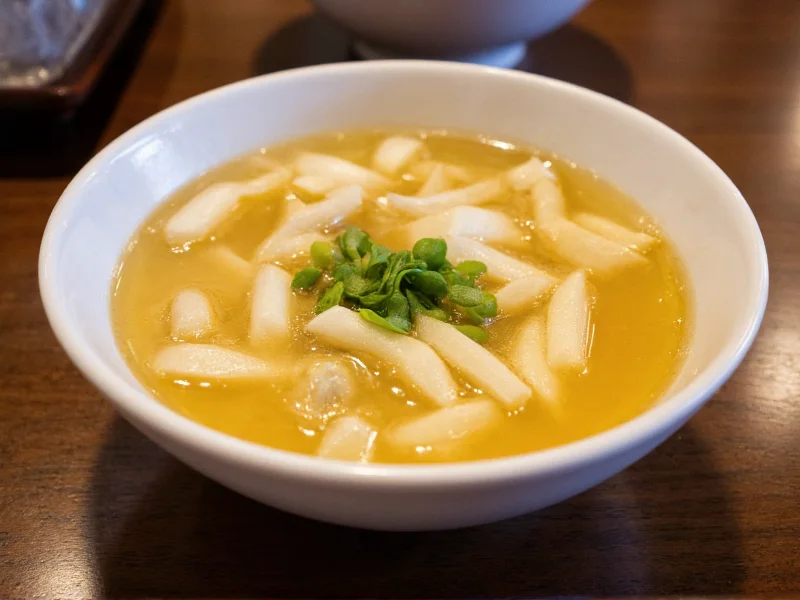Daikon radish soup represents one of Asia's most cherished culinary traditions, blending simplicity with profound health benefits. This humble yet sophisticated dish transforms the large white radish—known as daikon in Japanese (literally “big root”)—into a comforting broth that’s both light and deeply flavorful. Unlike its spicy red radish cousins, daikon offers a delicate sweetness that mellows beautifully when cooked, making it perfect for nourishing soups.
Why Daikon Radish Soup Deserves a Place in Your Kitchen
More than just a seasonal specialty, daikon radish soup delivers remarkable versatility across dietary preferences. Whether you’re following a vegan, gluten-free, or low-sodium diet, this soup adapts effortlessly while maintaining its signature clean flavor profile. Nutritionists particularly praise its enzyme content—daikon contains myrosinase, which aids digestion and helps break down cruciferous vegetables when consumed raw.
Essential Ingredients and Their Roles
The magic of authentic daikon soup lies in ingredient synergy. While regional variations exist, these core components create the foundation:
| Ingredient | Function | Substitution Options |
|---|---|---|
| Daikon radish (1 medium) | Primary flavor base and texture | Turnips or parsnips (less ideal) |
| Kombu (4x6 inch piece) | Creates natural umami depth | Dried shiitake mushrooms |
| Fresh ginger (1 inch) | Adds warmth and aids digestion | Fresh turmeric (different flavor profile) |
| Miso paste (3 tbsp) | Provides probiotics and savory notes | Soy sauce (reduces health benefits) |
Step-by-Step Preparation Guide
Creating exceptional daikon radish soup requires attention to cooking sequence. Follow these steps for optimal flavor development:
- Prepare the dashi broth: Soak kombu in 4 cups cold water for 30 minutes. Heat to 160°F (71°C), remove kombu just before boiling to prevent sliminess.
- Process daikon: Peel and cut into 1/4-inch half-moons. For creamier texture, puree half the daikon after cooking.
- Simmer vegetables: Add daikon and ginger to broth, simmer 20-25 minutes until daikon turns translucent at edges.
- Incorporate miso: Remove from heat, whisk in miso paste (never boil miso to preserve probiotics).
- Finish: Add scallions and a splash of rice vinegar just before serving.
Avoiding Common Preparation Mistakes
Even experienced cooks encounter pitfalls with daikon soup. These evidence-based tips ensure success:
- Don’t overcook daikon: Extended boiling makes it mushy and diminishes nutritional value. Test tenderness at 20 minutes.
- Maintain proper miso temperature: Adding miso to boiling liquid kills beneficial bacteria. Keep broth below 165°F (74°C).
- Balancing bitterness: If daikon tastes sharp, add 1 tsp sugar or a strip of dried kombu during cooking.
- Sodium control: Use low-sodium miso and adjust seasoning at the end for dietary needs.
Cultural Variations Worth Exploring
Daikon soup appears across Asian cuisines with distinctive regional interpretations:
- Japanese Daikon No Osumashi: Clear broth featuring delicate daikon slices, often served during New Year celebrations for purification.
- Korean Kkakdugi Guk: Fermented kimchi radish soup with gochujang, providing probiotic benefits and spicy complexity.
- Chinese Lo Bak Gao: Hearty version with pork bones and dried scallops, simmered for hours to extract maximum collagen.
- Modern Western adaptation: Roasted daikon soup with coconut milk for creaminess, appealing to dairy-free diets.
Nutritional Powerhouse Analysis
One cup (240ml) of traditional daikon radish soup delivers remarkable nutritional value without significant calories:
| Nutrient | Amount per Serving | Health Significance |
|---|---|---|
| Calories | 35 kcal | Ideal for weight management |
| Vitamin C | 27% DV | Boosts immune function and collagen synthesis |
| Digestive enzymes | Naturally occurring | Supports gut health and nutrient absorption |
| Potassium | 18% DV | Regulates blood pressure and fluid balance |
| Fiber | 2.3g | Promotes satiety and healthy digestion |
Research published in the Journal of Food Science and Technology confirms daikon’s glucosinolates transform during cooking into compounds with anti-inflammatory properties. The soup’s low glycemic index (estimated 15) makes it suitable for diabetes management when prepared without added sugars.
Seasonal Serving Recommendations
While daikon radish soup works year-round, seasonal adjustments maximize its benefits:
- Winter preparation: Add warming elements like toasted sesame oil and black pepper to support circulation.
- Spring cleansing: Incorporate fresh herbs like cilantro and mint for detoxification support.
- Summer variation: Serve chilled as hiyayakko-style soup with tofu cubes for heat relief.
- Fall transition: Add roasted mushrooms for earthy depth during seasonal changes.
Store properly cooked daikon soup in airtight containers for up to 4 days in the refrigerator. Freezing is not recommended as it alters the radish’s delicate texture. Always reheat gently without boiling to preserve enzymatic benefits.
Frequently Asked Questions
How long does daikon radish soup last in the refrigerator?
Properly stored in an airtight container, daikon radish soup maintains quality for 3-4 days in the refrigerator. Always reheat gently without boiling to preserve the beneficial enzymes and delicate flavor profile. Freezing is not recommended as it significantly alters the radish's texture.
Can I make daikon radish soup without miso paste?
Yes, you can create a flavorful base using kombu and dried shiitake mushrooms for umami. While miso contributes valuable probiotics, the soup remains nutritious without it. For similar depth, try adding a small piece of dried kombu during simmering or a teaspoon of nutritional yeast for savory notes.
Why does my daikon soup taste bitter?
Bitterness typically occurs when daikon is overcooked or when using older, woody specimens. To prevent this, simmer just until tender (20-25 minutes), add a strip of dried kombu during cooking, or include 1 teaspoon of sugar to balance flavors. Choosing younger daikon with smooth skin also reduces bitterness.
Is daikon radish soup suitable for weight loss diets?
Yes, with approximately 35 calories per cup and 2.3g of fiber, daikon radish soup makes an excellent addition to weight management plans. Its high water content and fiber promote satiety while providing essential nutrients. For maximum benefit, avoid adding high-calorie ingredients like heavy cream or excessive oils.











 浙公网安备
33010002000092号
浙公网安备
33010002000092号 浙B2-20120091-4
浙B2-20120091-4